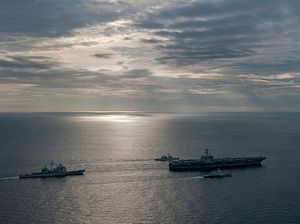Last week, a Malaysian-registered tanker went missing in the South China Sea near Johor. Though the vessel – believed to be hijacked – still has not been found a week later, the Malaysian government is stepping up its rescue efforts with the help of other neighboring states and willing partners.
The tanker, the MT Orkim Harmony, suddenly lost contact around 8:50pm Thursday night. It was filled with nearly 6,000 tons of RON95 petrol worth some 21 million ringgit (US$5.6 million) and had 22 crew members on board, including 16 Malaysians, five Indonesians and a Myanmar national. Malaysian authorities immediately began combing surrounding waters after they received a missing tanker report from the shipping company Orkim Ship Management Sdn Bhd on Friday morning. But after nearly 50,000 square kilometers has been searched over the past few days, the vessel has yet to be found.
Malaysian officials now believe that the vessel was hijacked. On Monday, Vice Admiral Ahmad Puzi Ab Kahar, deputy director general of the operations unit of the Malaysian Maritime Enforcement Agency, described it as a “confirmed case of piracy.” On Tuesday, Home Minister Ahmad Zahid Hamidi was less certain but nonetheless acknowledged that it was the most likely outcome, and perhaps even aided by an “inside job,” considering the fact that there was clearly knowledge of where the tanker was and what it was carrying.
That appears to be the most plausible explanation, particularly since a similar incident occurred to another Malaysia-registered oil tanker from the same company earlier this month around the same area. On June 4, several armed perpetrators boarded the Orkam Victory, brought the ship to another location and siphoned off diesel for seven hours to another tanker before fleeing towards Indonesia. These are not isolated incidents. According to data from the Regional Cooperation Agreement on Combating Piracy and Armed Robbery against Ships in Asia (ReCAAP), this is already the 8th incident of siphoning of fuel reported in Asia since January 2015, most of which have occurred in the South China Sea.
However, Vice Admiral Ahmad Puzi said that in this particular case, it may be more difficult for the hijackers to replicate the siphoning effort they pulled off earlier this month. Attempting a ship-to-ship transfer with RON95 petrol, he said, is more difficult because it is highly flammable, and it requires special safety requirements and equipment. Based on that fact, he said Malaysian authorities believed that the hijackers were looking for facilities to transfer the petrol, the closest of which were in Thailand, Brunei and Vietnam.
Meanwhile, Malaysia has intensified its search for the vessel. On Tuesday, the Ahmad Puzi revealed that that five aircraft – two from the MMEA, two from the Royal Malaysian Air Force, and one from the Royal Malaysian Navy – had joined in the effort to search for the tanker in addition to 13 search vessels mobilized since the first day. The search area has also been widened to include the Malacca Strait as well as Sabah and Sarawak waters.
He also said that Malaysia was increasingly working with other countries to locate the vessels. Neighboring Southeast Asian governments were already notified of the incident once Malaysian authorities received word, and Malaysia also subsequently forwarded the missing tanker report to Singapore and Indonesia. In addition, Malaysia has requested help from Indonesian authorities to search their in their waters as the “highest possibility” – according to Ahmad Puzi – is that the tanker is in the islands of Natuna and Anambas. Authorities have also increasingly turned to satellite technology to track down the missing tanker in collaboration with other Southeast Asian states. Thus far, they say the satellites have failed to detect the position and signals from the ship for various reasons including weather conditions.
Other countries have also joined in the effort or are expected to do so. On Tuesday, Ahmad Puzi revealed that a P-3C Orion aircraft from Australia had joined in the search operation that afternoon. He also added that the United States had also agreed to send another aircraft as well.
Still, Malaysian authorities have warned that the search operation could go on for a while since much is still uncertain. The search area has already expanded significantly. The tanker can reportedly be at sea for about 20 days before it runs out of fuel, and thus far, the Malaysian government says it has not received any requests for ransom. The one cause for optimism is that the crew of the Orkam Victory was eventually let free once the hijackers had gotten what they came for, and hopefully this will be the case here as well.
In the meantime, in a June 12 report, ReCAAP advised shipmasters and crew to “exercise enhanced vigilance when transiting the area.”
































